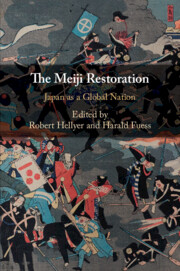24 results
5 - Foreign Relations and Coastal Defense under the Mature Tokugawa Regime
- from Part I - The Character of the Early Modern State
-
-
- Book:
- The New Cambridge History of Japan
- Published online:
- 15 January 2024
- Print publication:
- 23 November 2023, pp 159-183
-
- Chapter
- Export citation
Joshua A. Fogel and Matthew Fraleigh (eds): Sino-Japanese Reflections: Literary and Cultural Interactions between China and Japan in Early Modernity vi, 325pp. Berlin: De Gruyter, 2022. ISBN 978 3 11077642 3.
-
- Journal:
- Bulletin of the School of Oriental and African Studies / Volume 86 / Issue 3 / October 2023
- Published online by Cambridge University Press:
- 04 December 2023, pp. 595-596
- Print publication:
- October 2023
-
- Article
- Export citation
9 - Early Modern Japan: A State with Limited Migration
- from Part III - Short-Distance Trade
-
-
- Book:
- The Cambridge History of Global Migrations
- Published online:
- 12 May 2023
- Print publication:
- 01 June 2023, pp 179-196
-
- Chapter
- Export citation
The Dutch Overseas Empire, 1600–1800. By Pieter C. Emmer and Jos J. L. Gommans. Cambridge: Cambridge University Press, 2021. xiii, 465 pp. ISBN: 9781108428378 (paper).
-
- Journal:
- The Journal of Asian Studies / Volume 80 / Issue 4 / November 2021
- Published online by Cambridge University Press:
- 10 January 2022, pp. 1142-1144
- Print publication:
- November 2021
-
- Article
- Export citation
Tables
-
- Book:
- The Meiji Restoration
- Published online:
- 14 April 2020
- Print publication:
- 07 May 2020, pp ix-ix
-
- Chapter
- Export citation
Acknowledgments
-
- Book:
- The Meiji Restoration
- Published online:
- 14 April 2020
- Print publication:
- 07 May 2020, pp xiii-xiii
-
- Chapter
- Export citation
Notes on Conventions
-
- Book:
- The Meiji Restoration
- Published online:
- 14 April 2020
- Print publication:
- 07 May 2020, pp xiv-xvi
-
- Chapter
- Export citation
8 - Imai Nobuo
- from Part 2 - Internal Conflicts
-
-
- Book:
- The Meiji Restoration
- Published online:
- 14 April 2020
- Print publication:
- 07 May 2020, pp 171-188
-
- Chapter
- Export citation
Introduction
-
-
- Book:
- The Meiji Restoration
- Published online:
- 14 April 2020
- Print publication:
- 07 May 2020, pp 1-12
-
- Chapter
- Export citation
Part 2 - Internal Conflicts
-
- Book:
- The Meiji Restoration
- Published online:
- 14 April 2020
- Print publication:
- 07 May 2020, pp 111-188
-
- Chapter
- Export citation
Suggestions for Further Reading
-
- Book:
- The Meiji Restoration
- Published online:
- 14 April 2020
- Print publication:
- 07 May 2020, pp 266-276
-
- Chapter
- Export citation
Copyright page
-
- Book:
- The Meiji Restoration
- Published online:
- 14 April 2020
- Print publication:
- 07 May 2020, pp iv-iv
-
- Chapter
- Export citation
Index
-
- Book:
- The Meiji Restoration
- Published online:
- 14 April 2020
- Print publication:
- 07 May 2020, pp 277-284
-
- Chapter
- Export citation
Part 3 - Domestic Resolutions
-
- Book:
- The Meiji Restoration
- Published online:
- 14 April 2020
- Print publication:
- 07 May 2020, pp 189-265
-
- Chapter
- Export citation
Contributors
-
- Book:
- The Meiji Restoration
- Published online:
- 14 April 2020
- Print publication:
- 07 May 2020, pp x-xii
-
- Chapter
- Export citation
Contents
-
- Book:
- The Meiji Restoration
- Published online:
- 14 April 2020
- Print publication:
- 07 May 2020, pp v-vi
-
- Chapter
- Export citation
Figures
-
- Book:
- The Meiji Restoration
- Published online:
- 14 April 2020
- Print publication:
- 07 May 2020, pp vii-viii
-
- Chapter
- Export citation
Part 1 - Global Connections
-
- Book:
- The Meiji Restoration
- Published online:
- 14 April 2020
- Print publication:
- 07 May 2020, pp 13-110
-
- Chapter
- Export citation

The Meiji Restoration
- Japan as a Global Nation
-
- Published online:
- 14 April 2020
- Print publication:
- 07 May 2020
The Pacific and its place in global history - Pacific histories: ocean, land, people Edited by David Armitage and Alison Bashford. Basingstoke: Palgrave Macmillan, 2013. Pp. xiv + 371. Hardback £65.00, ISBN 978–1–137–00165–8; paperback £19.99, ISBN 978–1–137–00163–4. - Navigating the Spanish lake: the Pacific in the Iberian world, 1521–1898 By Rainer F. Buschmann Edward R. SlackJr, and James B. Tueller. Perspectives on the global past. Honolulu, HI: University of Hawai‘i Press, 2014. Pp. xii + 182. Hardback £43.50, ISBN 978–0–8248–3824–9. - Science, voyages, and encounters in Oceania, 1511–1850 By Bronwen Douglas. London: Palgrave Macmillan, 2014. Pp. xx + 361. Hardback £65.00, ISBN 978–1–137–30588–6. - The great ocean: Pacific worlds from Captain Cook to the Gold Rush By David Igler. Oxford and New York: Oxford University Press, 2013. Pp. xi + 255. Hardback £20.99, ISBN 978–0–19–991495–1.
-
- Journal:
- Journal of Global History / Volume 11 / Issue 2 / July 2016
- Published online by Cambridge University Press:
- 03 June 2016, pp. 295-302
- Print publication:
- July 2016
-
- Article
- Export citation



